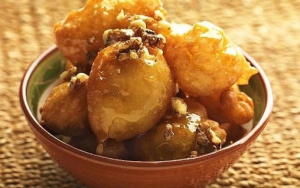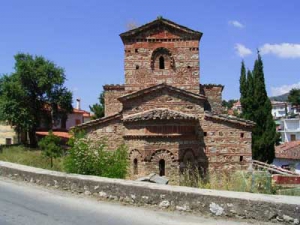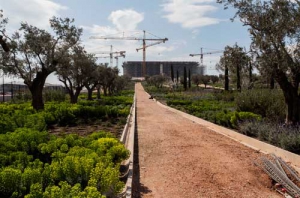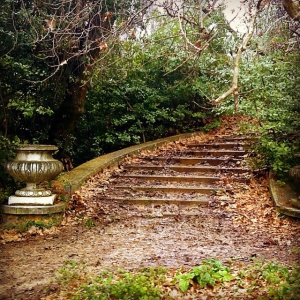LIFE & CULTURE
XpatAthens
Thursday, 28 May 2015 07:00
Patras University Student Develops Eye-Typing Technology App
The University of Patras in Greece has once again been put under the spotlight, thanks to Evangelos Skodras’ double distinction for the development of EyeType. Skodras is a PhD student at the Wire Communications Laboratory of the Department of Electrical and Computer Engineering at the University of Patras.
Skodras developed an Android app called EyeType that gives the user the possibility to control what is typed on the device’s keyboard with his eyes, by recording the person’s eye movement.
This is a real innovation in the field that will enable people suffering from ALS (Amyotrophic Lateral Sclerosis), LIS syndrome (Locked-In Syndrome) or quadriplegia – who are only able to move their eyes – to communicate by using a smartphone or tablet.
To read more, please visit: Greek Reporter
To read more, please visit: Greek Reporter
Published in
Greece In The News
Tagged under
Thursday, 28 May 2015 07:00
Homemakers With The Golden Touch: Making Something Out Of Nothing
Perhaps the most touching part of tradi -tional Greek cooking is what we call “Recipes Made from Scratch.”
Loukoumades (fried dough pastry), tiganites (pancakes), kourkoubinia (little phyllo rolls)… “Fried sweets” are among the most popular pastries in traditional Greek cuisine and they have made generations and generations of children’s faces gleam with joy over the years. And yet, these countless moments of pure childhood delight were masterfully made “from scratch:” a handful of flour and water with some olive oil for frying. Freshly baked bread is also made from “scratch,” and even today when it comes out of the oven nice and hot, even the most conscientious carb counter cannot resist reaching over for a slice. Flour, olive oil, and water are also the basic ingredients in a pita (pie), which often contained nothing more than a few wild greens that some homemaker picked along a trail on the way back home from the field and carefully stashed in her apron.
They say that the foundation of traditional Greek cooking is the trio of flour, olive oil, and wine. And when we hear the word “foundation,” it is usually implied that it will serve as the basis for some “superstructure” that will soon follow, where all the ingredients will ultimately come together to form the entirety of a dish. The (somewhat bitter) irony in the whole matter is that, as we have seen, Greek folk cooking has some very popular recipes to showcase where the initial foundation and the final product are one and the same – while the gastronomical “superstructure” never appears. And the irony is somewhat “bitter” because this observation testifies to the existence of a cuisine in which everyday cooks –the housewives with the “golden touch” – learned their art not at some culinary seminar, but from the necessities of life.
These women had to bear the burden of providing for the daily sustenance of a typically large family living in a poor and harsh natural or social environment. Some were farmers who were not fortunate enough to be born in the so-called “blessed” lands of the Mediterranean, next to fertile plains with well-fed livestock, fruit-bearing trees, plentiful gardens, abundant water, and cultivable soil, but rather in some “hellacious” mountainous crag also located in the Mediterranean, where you’d shudder in fear when it started to snow, or in some weather beaten, scalding “barren island,” where the only thing you’d think grew there were rocks. Still others were members of the early “urban” working class… You know the ones… those who lived in Athens in the 1920s, 77 percent of whom packed their entire family into a one-room home, with 41 percent of them (adults and children alike) sharing the same bed. And then again, there were others whose destiny included having to feed their entire family amidst wars and displacement.
To read more, please visit: i Cook Greek
To read more, please visit: i Cook Greek
Published in
Greek Food & Diet
Tagged under
Wednesday, 27 May 2015 07:00
SkyGreece Spreads Wings To Connect Greeks Far And Wide With Motherland
Aiming to boost connections between Greece, the US and Canada, SkyGreece Airlines presented its plans last week to the Hellenic Association of Travel and Tourist Agencies (HATTA), with sights on garnering their support.
The Markopoulos-based carrier, founded in Greece in October 2012 by a team of Greek-Canadian businessmen, aims to connect the Greek diaspora to Greece by offering non-stop flights between Athens and North America (Chicago & Boston), with plans to offer flights to South Africa in the near future.
The first direct Athens-New York route will launch on June 19 2015.
With headquarters in Athens, SkyGreece also has offices in New York, Toronto and Montreal and employs 150 people, 100 of whom are based in Greece.
HATTA President Lysandros Tsilidis welcomed the new initiative, stating;
“The air link is an important tool for travel agencies that deal with incoming tourism from the US and Canada, which is particularly dynamic, for expatriates, and of course, is expected to play an important role in outbound tourism by offering competitive prices.”
To read more, please visit: Greek Travel Pages
To read more, please visit: Greek Travel Pages
Published in
Local News
Tagged under
Tuesday, 26 May 2015 07:00
The Clumsies - A Bar Hidden Away
The Clumsies is a newly opened, prestigious bar housed in an old 1919 neoclassical mansion, located in central Athens near Monastiraki and Panepistimio Metro stations. It’s actually hidden off a small square on Praxitelous street, at number 30.
"[A] bartender is not only judged by the impeccable execution of a recipe, but also by the way he connects with customers." Nikos Bakoulis, the co-owner of The Clumsies, used to bartend in 2012 with fellow co-owner Vassilis Kyritsis. This was their philosophy – and the Clumsies was born as follows:
" …bring them [Vassilis and Nikos] into contact with three industrious businessmen in the hospitality sector: Lefteris Georgopoulos, Thanos Tsounakas, and Giorgos Kaissaris. Stir gently, then serve."
The Room
The two roomed private area is like stepping into a ‘Gentleman’s Club’ and can host up to ten people for an evening. Decked out with feature fireplace, bookcase, billiard table and vinyl LPs, the mood here is somewhat more formal. With your own private bar tender, Nikos can create a concoction of cocktails, tailor made to suit the individual: rum, vodka or gin based with a variety of ingredients.
To read more, please visit: Life Beyond Borders
Clumsies Website: http://www.theclumsies.gr/
Clumsies On Facebook
Photo Credit: The Clumsies
To read more, please visit: Life Beyond Borders
Clumsies Website: http://www.theclumsies.gr/
Clumsies On Facebook
Photo Credit: The Clumsies
Published in
Pubs, Bars & Cafes
Tagged under
Tuesday, 26 May 2015 07:00
Byzantine Kastoria In Greece
The Byzantine emperors, it is said, regularly exiled dissident members of their court to Kastoria. Like Ochrid to the north, half-way across the breadth of the Balkans on an artery reaching from Constantinople to the Adriatic Sea, evidently exile in this little Greek lakeside resort was meant to be a chastening punishment.
Today, such punishment is a rare pleasure. Kastoria boasts a Byzantine heritage that seems second to Constantinople. But, unlike Istanbul, this little town in summertime enjoys a captivating serenity. In wintertime, I should add, it is entirely different, so they say. For this is the fur capital of Greece, a status it owes to its ancient heritage of trapping beaver (beaver in Greek being kastori, with the plural being kastoria) in Lake Orestiadha. An inexplicable number of shops fit out Greece’s best-dressed women in bulky coats as well as tight leather, risking political incorrectness in most other European countries.
Lake Orestiadha is graced by pelicans. These bewitchingly beautiful birds circle around the lakeside like jumbo jets before effortlessly descending, twisting then gliding to plop onto the water close to shore alongside the ungainly but distinctive watercraft here. The restless pelicans catch your eye as you enter the town, which has colonised the isthmus of a steep and bulbous promontory reaching out into the northern part of the lake. Refurbished Roman fortifications belonging to ancient Celetrum were probably first renovated in the 6th century AD when this had become Justinianopolis. These were strengthened again with 13th century bastions by the Epirot Despots. The unevenly restored walls extend across the narrow neck, in front of which is the daily market of local farmers, men and women from the slopes of the Grammos mountains, wizened by long summers. Rising steeply behind the walls is the modern town with its roots in Byzantium and the Ottoman age. Along the west-facing shoreline is a string of bright cafés; this is the heart of the present city. By contrast, the east-facing shoreline, tracked by a promenade, is shaded by planes and has an elegiac air. Here the discrete sense of serenity is profound as the trees drift past the excellent Kastoria Hotel into the thicker woodland that shrouds the narrow sylvan track that winds around the promontory a distance of some six miles.
To read more, please visit World Archaeology Today, such punishment is a rare pleasure. Kastoria boasts a Byzantine heritage that seems second to Constantinople. But, unlike Istanbul, this little town in summertime enjoys a captivating serenity. In wintertime, I should add, it is entirely different, so they say. For this is the fur capital of Greece, a status it owes to its ancient heritage of trapping beaver (beaver in Greek being kastori, with the plural being kastoria) in Lake Orestiadha. An inexplicable number of shops fit out Greece’s best-dressed women in bulky coats as well as tight leather, risking political incorrectness in most other European countries.
Lake Orestiadha is graced by pelicans. These bewitchingly beautiful birds circle around the lakeside like jumbo jets before effortlessly descending, twisting then gliding to plop onto the water close to shore alongside the ungainly but distinctive watercraft here. The restless pelicans catch your eye as you enter the town, which has colonised the isthmus of a steep and bulbous promontory reaching out into the northern part of the lake. Refurbished Roman fortifications belonging to ancient Celetrum were probably first renovated in the 6th century AD when this had become Justinianopolis. These were strengthened again with 13th century bastions by the Epirot Despots. The unevenly restored walls extend across the narrow neck, in front of which is the daily market of local farmers, men and women from the slopes of the Grammos mountains, wizened by long summers. Rising steeply behind the walls is the modern town with its roots in Byzantium and the Ottoman age. Along the west-facing shoreline is a string of bright cafés; this is the heart of the present city. By contrast, the east-facing shoreline, tracked by a promenade, is shaded by planes and has an elegiac air. Here the discrete sense of serenity is profound as the trees drift past the excellent Kastoria Hotel into the thicker woodland that shrouds the narrow sylvan track that winds around the promontory a distance of some six miles.
Published in
Travel Greece
Tagged under
Monday, 25 May 2015 07:00
At Cannes, A Greek Filmmaker Explains Move To English-Language Film
“Dogtooth,” a 2009 Oscar-nominated film by the Greek director Yorgos Lanthimos, was a distorted family drama. “The Lobster,” which debuted at the Cannes Film Festival to critical acclaim, takes Mr. Lanthimos’s darkly comic dystopian vision to a deeper level and a much wider audience than ever before.
Written by Mr. Lanthimos and his longtime collaborator, Efthimis Filippou, in their sui generis deadpan style, the film imagines a world in which single people must check into a hotel and if they don’t find a partner within 45 days, they are turned into animals. The film explores with dark hilarity the contorted ways in which people try to find — or force — affinities.
“Someone said, ‘You’re so cynical, you see relationships this way,’ and I said, ‘Well, this is the most romantic film I’ve ever made,’” Mr. Lanthimos said in an interview here. “I always like contradiction in everything I do. It’s both for me an honest view of human relationships, and it has a romantic side of it which is kind of fighting with the more cynical view.”
After “Dogtooth,” which won a prize at Cannes in 2009 and “Alps,” (2011), both low-budget Greek-language films that won Mr. Lanthimos a cult following, “The Lobster” was filmed in Dublin in English. It stars Colin Farrell; John C. Reilly — who appears in three films at this year’s festival — Rachel Weisz; Léa Seydoux; the British television actress Olivia Colman; and Ariane Labed, a Greek-born French actress who is married to Mr. Lanthimos.
“The Lobster” has been one of the most-talked-about films at the festival. The Hollywood Reporter said Mr. Lanthimos “makes a practically effortless transition to the big leagues.” Variety called it “supremely singular” and “a wickedly funny protest against societal preference for nuclear coupledom that escalates, by its own sly logic, into a love story of profound tenderness and originality.”
For more on this, please visit the New York Times
by Rachel Donadio
Published in
Greece In The News
Tagged under
Monday, 25 May 2015 07:00
Niarchos Center Starts To Take Shape
Cultural venue in southern Athens to house National Opera and Library.
Dressed in a hard hat, rain boots and a fluorescent yellow vest for a group tour of the under-construction Stavros Niarchos Foundation Cultural Center (SNFCC), including the new homes of the National Opera and Library, as well as a 170,000-square meter park on the shore of Faliro Bay in southern Athens, I spotted a small detail that made me smile: In the building site’s staff cloakroom, where SNFCC supervisors and architects have lockers with their names on them, I was standing next to the one belonging to Renzo Piano. The celebrated Italian architect, in charge of designing the buildings, other structures and surrounding green spaces of the new complex, is closely following each stage of the colossal project’s development during his regular visits to Athens.
Two young foundation executives acted as our guides: 40-year-old chief operating officer John Zervakis and 30-year-old assistant chief operating officer Lenia Vlavianou, both of whom have been overseeing the project since its start. They represent a new generation of Athenians set to witness a dream come true during the crisis years.
Inside the former horse racing track’s vast space, things are beginning to take shape. Upon first glance the site’s green areas – essentially a beautiful Mediterranean garden – look almost ready with only a few final touches missing.
Meanwhile, the construction site resembles a beehive, with its hundreds of workers and cranes in motion. This is where Piano’s genius lies: the sense that you’re in a place where heaven and earth meet, a gigantic sheltered spot where the city meets the water.
The site’s main entrance is on Peisistratou Street. First we passed in front of the 1,000-vehicle parking area before moving on to Poseidonos Avenue, then toward Syngrou Avenue and the new National Opera’s facade. An open space called the Agora – to serve as a visitors’ reception area – will also make an appearance here, while the new buildings of the National Library extend along Syngrou Avenue. This is where a 400x30-meter canal that will also serve as a flood control will be constructed. The ride continued toward the area where the park begins.
For more on this story, please visit ekathimerini
Story by Margarita Pournara
Published in
Local News
Tagged under
Friday, 22 May 2015 14:00
Exploring Parnitha & The Tatoi Estate
With nothing planned for Saturday (for once!) and sunny skies overhead, I decided to plan an afternoon escape from the city. As it still felt a bit too early for a dip in the sea, I called up a friend and made a quick decision to head north to Mount Parnitha. We loaded our bicycles on the back of the car and drove the quick 30minutes on the national road.
Parnitha is a forested mountain range north of Athens, the highest on the Attica peninsula, with an elevation of 1400m. It has something for all nature lovers: endless forest, walking trails, off-road bicycle trails, picnic areas, etc. There are several ways in once you get to the area, with parking lots and maps posted. On this day, there were numerous other families and groups enjoying the day.
Parnitha is the location of the Tatoi estate. Tatoi was the summer home and 10,000 acre estate of the former Greek royal family, and the birthplace of King George II of Greece. You can walk around and see the old buildings of the estate. These are all derelict now, and in need of some attention – but you can get a bit of a sense of ‘the past’ from your visit.
There is a great history of the estate written by Kostas Stamatopoulos, here: http://www.tatoi.org/?page_id=69 (scroll to the bottom of the page for English).
Parnitha is also the location of the popular Regency Casino, accessible by cable car/teleferik. As our day was about exercising our bodies vs exercising our luck, we did not visit the casino on this trip, but made a mental note to come back ;)
I would describe the section of Parnitha that we visited as ‘rough and wild’ vs ‘groomed and cultivated’. Of course, we didn't see the whole area in one afternoon, but it certainly felt like a nice escape from the city, some good exercise and some fresh mountain air. Not a bad way to spend a Saturday.
Until next week,
Jack
Parnitha Visitor Overview
Tatoi Info (in Greek, some English):
www.tatoi.org
www.tatoi.org
Regency Casino
Published in
My Week In Athens
Tagged under
Friday, 22 May 2015 07:00
Greece Goes Through To The Eurovision Grand Final
Greece has made it through to the Grand Final of the Eurovision song contest after Maria-Elena Kyriakou’s dynamic and at the same time emotional performance of ‘One Last breath’, a song she co-wrote with Efthyvoulos Theoharous, during last night’s first semi-final impressed the crowd attending Vienna’s Wiener Stadthalle arena and won the vote of both the TV viewers and that of the professional juries.
The 31-year old, mother of three, Cypriot-born singer will be joined in this Saturday’s final by nine other acts from Serbia, Armenia, Belgium, Estonia, Hungary, Russia, Albania, Romania and Georgia.
Finland, Moldova, Netherlands, FYROM, Belarus and Denmark failed to qualify for the final.
As one of the ‘Big Five’ countries, the UK has gained automatic qualification to the Grand Final alongside Spain, Germany, France, Italy and current title holders Austria.
To read more, please visit London Greek Radio
Published in
Local News
Tagged under
Friday, 12 August 2022 07:00
Name Days & Name Day Customs In Greece
Name days are celebrated in many European countries. The tradition stems from the Christian church where specific days are dedicated to a saint's 'feast day.' In Greece, name days are widely celebrated, and traditionally they are more important than a birthday, particularly as people get older.
How Name Days Are Celebrated In Greece
Traditionally, name days are celebrated as an 'open house' where close friends and relatives drop by to give their wishes, offer a small gift, and receive the traditional 'kerasma' (food, sweets, coffee, and drinks). In recent years the 'open house' tradition has changed and name days are celebrated by invitation.
It is customary to call and offer wishes and congratulate someone on their name day – it's now also acceptable to send your wishes on social media too!! If a friend has a name day, then you wish them 'Chronia Polla' (Many Years) – a wish for good health and prosperity.
Name Giving Traditions In Greece
Naming conventions in Greece are still followed quite strictly, with the result that certain names are used for many individuals in a generation. In each generation, the eldest grandson in each family will be named after the grandfather, and the eldest granddaughter will be named after the grandmother. If someone had three children, and they all produce a male grandchild, all three of those cousins will have the same name. To top it all off, all those with the same first name will celebrate the same saint's Name Day.
Never Miss A Greek Nameday
XpatAthens has a name day widget at the bottom of our homepage. This widget is updated automatically with the names that are celebrated each day.
Published in
Greek Traditions
Tagged under














